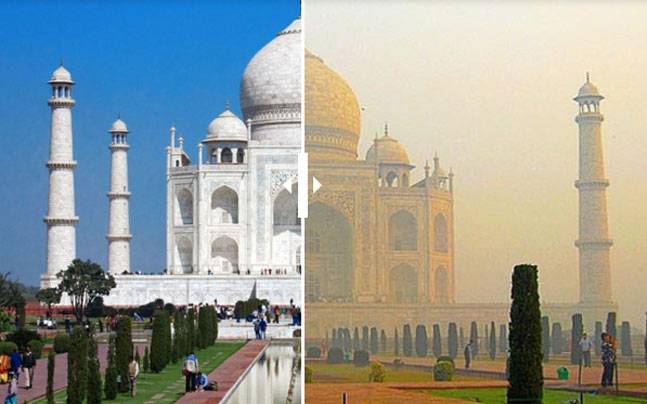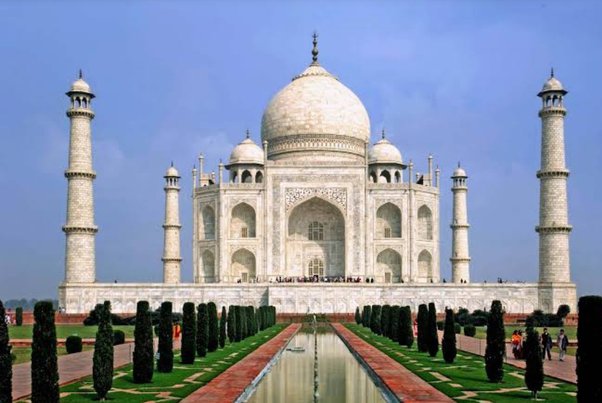
5 Effects of Air Pollution on the Taj Mahal
The Taj Mahal — the pristine white marble mausoleum built by Mughal emperor Shah Jahan for his beloved wife Mumtaz Mahal — has become increasingly yellow. The cause is the corrosive gases that are emitted into the air by nearby factories and automobiles.
The UNESCO World Heritage Site is protected by air pollution measures, including banning vehicles from the area and a monitor that gives a running count of the pollutants in the air. But these measures aren’t working fast enough.
1. Acid Rain
Acid rain is the result of gases, like sulfur dioxide and nitrogen oxides reacting with moisture in the air. These gases are released by power plants, factories and vehicles that burn fossil fuels. The acidic compounds then dissolve in rain water and wash over surfaces. This acid corrodes surfaces, including marble, and makes them yellow. This is one of the main causes of Taj Mahal’s discoloration.
The acidic compounds deposited on the monument — which is made of white marble — can etch it, changing its appearance and making it appear yellowish-brown in color. The acid also eats into the marble, causing it to break down.
The pollution in the area surrounding Taj Mahal is largely due to automobile fuels, brick manufacturing and open burning of waste and agricultural byproducts. Using cleaner fuels will cut the number of pollutants that cause acid rain and improve air quality in the area. It is also imperative that the Taj Trapezium – which includes Agra, Firozabad and Mathura – be free of industries that use coal or kerosene/furnace oil, and switch to LPG or natural gas.
2. Sulphur Dioxide
Five years ago, the Archaeological Survey of India told the Supreme Court that pollution from sulphur dioxide was the primary cause for the Taj Mahal’s deterioration. The pristine marble monument is burdened by a 24-hour layer of yellow-brown. Pollution from the contaminated river Yamuna presents another threat, as sewage and industrial waste contaminate its water. These nutrient-rich waters breed insects, whose excreta leave green patches on the Taj’s white marbles.
Sulphur dioxide is a gas that has a strong odour and is harmful to plants, animals, and humans. It is released by burning fossil fuels and during volcanic eruptions. When it reacts with water molecules in the air, it forms sulphuric acid. This corrodes the Taj’s marble.
Now a new study suggests that hydrogen sulphide, the gas produced by polluted water, is actually more damaging to the Taj than sulphur dioxide from factories. The water corrodes the stone, changing its colour and leaving cracks. The odour produced by this process also makes the Taj look less attractive. The study recommends that the water be tested for hydrogen sulphide levels near the Taj Mahal.
3. Smoke
The air pollution around the Taj Mahal is caused by burning of coal and other fossil fuels. This causes the formation of carbon dioxide, which in turn leads to an increase in earth’s temperature. This process is known as global warming. People living close to polluted areas are more prone to respiratory and heart diseases. This has also increased the number of lung cancer cases in the last few years.
Agra is one of the world’s most polluted cities, with a vast open dump that burns municipal waste and belches smoke. It is also home to a 200-year-old crematorium that uses wood pyres and emits smoke. The nearby oil refinery spews sulphur dioxide fumes.
The nearby Yamuna River, once hailed by Mughal emperor Babur as “better than nectar”, is among the most polluted waterways in the country. Millions of gallons of sewage and effluents flow into it every day. Plastic garbage, water bottles and polythene bags discarded by tourists are a common sight on its banks. Decomposing plastics produce methane gas, which stains marble and other surfaces.
4. Particulate Matter
The air contains solid particles (dust, soot and smoke) and gases that can be inhaled. These particles, which are less than 10 micrometers in size, can get into the lungs and cause respiratory problems. Particulate matter is also linked to heart disease and cancer. It can be found in outdoor air, indoor air and in some foods.
Until now, scientists were unsure of what was responsible for the Taj Mahal’s discolouration. However, a recent study has identified specific pollutants that are causing it to turn brownish-yellow. A team of researchers from the US and India used air-sampling equipment to measure the type of air pollution that’s hitting the monument, ScienceNOW reports. The scientists found that the light-absorbing particulate carbon in the air is to blame for the discolouration of the marble. This type of carbon comes from vehicle emissions, cooking smoke and frequent fires that burn rubbish and animal waste.
Another major source of PM in the Agra area is open municipal solid waste (MSW) burning, which accounts for about 50% of the organic material deposited on Taj Mahal’s surface. According to a source-apportionment study, this contributes more than the emissions from industrial activities and vehicular exhaust.
5. Aphid
The white marble of the Taj Mahal is fading and turning into a dingy yellow due to pollution. While the sulphur dioxide and nitrogen oxide released by India’s numerous factories and automobiles contribute to this, the polluted Yamuna River that flows by the Taj also has an impact. The foul-smelling hydrogen sulphide that gives the river its black foamy waters has been found to have corrosive effects on the marble of the Taj. This odour-causing gas has been found to have a stronger corrosive effect than the sulphur dioxide released from industrial pollution in Agra city.
The dumping of waste in the polluted Yamuna river that flows by the Taj Mahal has caused dark green patches to form on the 368-year-old monument’s white walls. The patches are the excreta of aphids, which have been breeding in the river because of the bacteria that are causing its deterioration.
The aphids can grow to the point where their numbers become too high, and they produce winged forms that are then transported away by insects or birds. These aphids then find new hosts, spreading their corrosive waste to other plants and damaging them as well.



WordPress database error: [Table './casirzxo_wp218/wp93_comments' is marked as crashed and last (automatic?) repair failed]
SELECT SQL_CALC_FOUND_ROWS wp93_comments.comment_ID FROM wp93_comments WHERE ( comment_approved = '1' ) AND comment_post_ID = 189 AND comment_parent = 0 ORDER BY wp93_comments.comment_date_gmt ASC, wp93_comments.comment_ID ASC